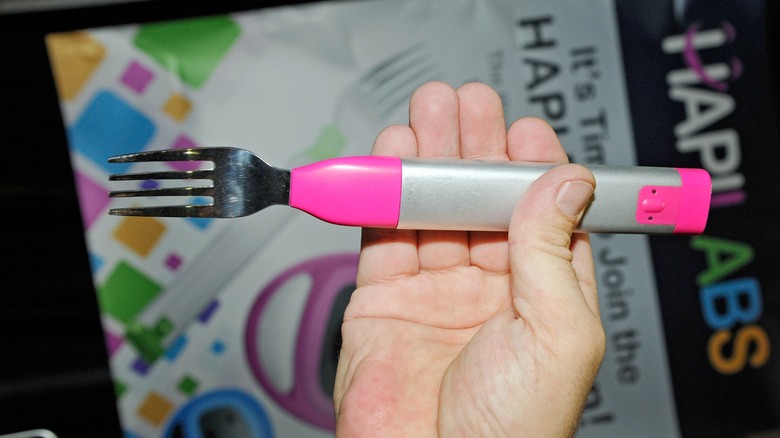What Does A Smart Fork Do And Are There Any Real Benefits To Using One?
According to a two year study started in August 2021, obesity was noted in around 40.3% of adults in the U.S., per CDC.gov. Considered a chronic health condition by many medical organizations, obesity carries with it an elevated risk for things like type 2 diabetes, heart disease, and stroke, among many others. It's no surprise then, that the weight loss industry has rapidly grown to never-before-seen heights estimated at nearly $90 billion in market value in 2023, per blog.marketresearch.com.
With several game-changing fitness gadgets to upgrade your workout routine, including products like smart rings, smart water bottles, and smart scales, the path to better health can be overwhelming. One idea to curb obesity that has surfaced in the last decade, is the smart fork, which attempts to prevent overeating by increasing the time taken in-between bites.
The Smart Feed Smart Fork for example, reminds you to slow down your eating pace using vibration, and lights. This concept is important because it takes around 20 minutes from your first bite before your brain can register your stomach is feeling full. While using a smart fork can certainly help prevent you from eating too quickly, it's not a guaranteed cure for weight loss and comes with a few caveats.
The potential benefits of eating more slowly
Modern society is fast-paced and results in many struggling to find time for simple things, like enjoying a nice meal. Unfortunately, food is often an afterthought, as professionals might have working lunches, students grab whatever they can on the go, and families dine in front of the television to wind down. In each scenario, the food on the plate isn't the center of attention. As a result, many Americans have developed habits that negatively contribute to their waistline. Absent-minded eating is one of the undesirable behaviors that smart fork technology can help remedy.
When you receive real-time feedback from a smart fork when consuming your meal too quickly, it causes you to pay closer attention to how you're eating. By eating more slowly, you can reduce the amount of food consumed, utilize more nutrients, and enhance digestion, to name a few benefits. Although, what foods you choose to eat are also important, making it a good idea to combine the smart fork with other tools, like Apple watch apps that will help you stick to your diet.
The drawbacks of smart fork products
While a smart fork can support slower and more mindful eating habits, it isn't without its problems. Inside a smart fork there is an accelerometer, which the device uses to identify movement whenever you take a bite. Unfortunately, it requires specific gestures to track movement. Meaning, if you don't follow a specific pattern of pointing the utensil down to stab your next helping of food, then raising your arm to a certain level when bringing the fork to your mouth, it won't register.
Beyond inaccurate motion tracking, smart forks are also very bulky when compared to the average utensil because of the electronic parts located inside. Not only can the thickness of a smart fork be inconvenient when eating, but you'll need to carry it around with you if not dining at home. While most people are used to always carrying a wallet and smartphone with them, its doubtful many are accustomed to toting sizeable tableware around in their pocket. If you're serious about getting into shape, many top-rated health and fitness apps for Android may provide a more significant impact on your well-being than a smart fork alone.


